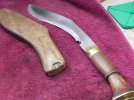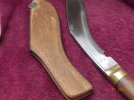-
The BladeForums.com 2024 Traditional Knife is ready to order! See this thread for details: https://www.bladeforums.com/threads/bladeforums-2024-traditional-knife.2003187/
Price is$300$250 ea (shipped within CONUS). If you live outside the US, I will contact you after your order for extra shipping charges.
Order here: https://www.bladeforums.com/help/2024-traditional/ - Order as many as you like, we have plenty.
You are using an out of date browser. It may not display this or other websites correctly.
You should upgrade or use an alternative browser.
You should upgrade or use an alternative browser.
Sheath Material
- Thread starter Mitch W.
- Start date
- Joined
- Jan 30, 2018
- Messages
- 2
Mitch, any kind of soft wood will work fine. I've used cedar fence boards. Easy to carve and you can get several scabbards from one board.
Bawanna
Moderator
- Joined
- Dec 19, 2012
- Messages
- 10,346
I agree on soft wood. I don't know for sure what they use in Nepal, I think they have a lot of the same trees we do, just different names.
I'd be tempted to try Basswood myself.. wood carvers like it cause its soft and doesn't have much grain pattern to it so I don't think it would be as likely to split.
I've made a couple wood sheaths but didn't nor never intended to wrap them in leather like the sarki's do.
Seeing video's of them making sheaths the wood is very blonde much like basswood, but could be most anything.
Good luck on the project.
I'd be tempted to try Basswood myself.. wood carvers like it cause its soft and doesn't have much grain pattern to it so I don't think it would be as likely to split.
I've made a couple wood sheaths but didn't nor never intended to wrap them in leather like the sarki's do.
Seeing video's of them making sheaths the wood is very blonde much like basswood, but could be most anything.
Good luck on the project.
Poplar should also work well. Not the softest wood, but soft enough, easy to work, easy to get hold of, and not likely to split.
What I suggest is, make the wood sheath first, two slabs hollowed out to fit the blade and fastened together at the edges. (Instead of actually carving out a hollow, it's easier to glue wood spacers around the edges to create an opening for the blade.) If you use a good quality wood this can be a fine sheath even without the leather wrapping, but you can add that afterward. (Some of the fancier khukuris by HI and others come with nicely carved all-wood sheaths.) As I recall, there's a tutorial on this in some forum posting or at the HI web site, but I can't find it. Maybe someone else can do better. Perhaps our resident search and retrieve expert, Steve Tall?
The trickiest part is matching the sheath to the knife so that it holds snugly but not too tight. You have to make the opening wider than the knife itself to allow room for the curved blade when sheathing and unsheathing. I suggest making a cardboard model first so you can fit the actual knife to the model, before making the permanent wood sheath. If you are going to add a leather wrap later, make the throat wide enough to fold the edge of the leather around without it pinching the blade. (Ideally the sheath should grip the blade along the spine, which is the thickest part. In many cases the sheath grips the blade at the throat where the bolster inserts, but this is less than ideal.)
There are some important details to consider, like any wood/leather project. How to fasten the edges of the two wood slabs, for example. In the traditional khukuri scabbard I believe it is just the leather wrap that holds them in place, which allows for some expansion and contraction due to heat and humidity. I would definitely give the wood slabs a good coat of waterproof sealant inside and out to minimize all that, and to prevent the wood from absorbing moisture that might tend to rust the blade over time.
What I suggest is, make the wood sheath first, two slabs hollowed out to fit the blade and fastened together at the edges. (Instead of actually carving out a hollow, it's easier to glue wood spacers around the edges to create an opening for the blade.) If you use a good quality wood this can be a fine sheath even without the leather wrapping, but you can add that afterward. (Some of the fancier khukuris by HI and others come with nicely carved all-wood sheaths.) As I recall, there's a tutorial on this in some forum posting or at the HI web site, but I can't find it. Maybe someone else can do better. Perhaps our resident search and retrieve expert, Steve Tall?
The trickiest part is matching the sheath to the knife so that it holds snugly but not too tight. You have to make the opening wider than the knife itself to allow room for the curved blade when sheathing and unsheathing. I suggest making a cardboard model first so you can fit the actual knife to the model, before making the permanent wood sheath. If you are going to add a leather wrap later, make the throat wide enough to fold the edge of the leather around without it pinching the blade. (Ideally the sheath should grip the blade along the spine, which is the thickest part. In many cases the sheath grips the blade at the throat where the bolster inserts, but this is less than ideal.)
There are some important details to consider, like any wood/leather project. How to fasten the edges of the two wood slabs, for example. In the traditional khukuri scabbard I believe it is just the leather wrap that holds them in place, which allows for some expansion and contraction due to heat and humidity. I would definitely give the wood slabs a good coat of waterproof sealant inside and out to minimize all that, and to prevent the wood from absorbing moisture that might tend to rust the blade over time.
Last edited:
Bawanna
Moderator
- Joined
- Dec 19, 2012
- Messages
- 10,346
That's basically what I did. I just used a spacer on the spine. I used some chop sticks on the blade side to create a guide for the edge to ride in.
The tricky part is making the top so the knife will go in and out taking into account the bend.
I thought at some point I might wrap mine with leather but never did. It worked fine as is.
Of course if you decide to forego the leather, you might want to find some prettier wood or come up with a plan to adorn it someway with carving or inlays or whatever.
I dig around and see if I can find a picture of my attempt.
The tricky part is making the top so the knife will go in and out taking into account the bend.
I thought at some point I might wrap mine with leather but never did. It worked fine as is.
Of course if you decide to forego the leather, you might want to find some prettier wood or come up with a plan to adorn it someway with carving or inlays or whatever.
I dig around and see if I can find a picture of my attempt.
- Joined
- Aug 26, 2010
- Messages
- 7,754
Wood flooring works well. Dumpster dive a few floor tile stores. They throw away all kinds of neat scaps that are not enough for them to keep but very nice quality wood. Glue and clamp using titebond III (waterproof stuff) If its thin enough wood it will act like a spring and retain the knife if your lucky enough and get it right. Do a fine sanding and rub down with boiled linseed oil.

An HI blade will probably require thicker welting .
.

Thats five layers clamped together including the welting and belt loop.

So far its holding up well! I suppose you could cover it in leather but this one turned out good enough to just leave it as is.
An HI blade will probably require thicker welting
Thats five layers clamped together including the welting and belt loop.
So far its holding up well! I suppose you could cover it in leather but this one turned out good enough to just leave it as is.



 I dont think Ive seen that one. I have an 18" Siru streaking around the bedroom that needs pants. I might try that style on it if I can catch it! I do like the side entry style.
I dont think Ive seen that one. I have an 18" Siru streaking around the bedroom that needs pants. I might try that style on it if I can catch it! I do like the side entry style.